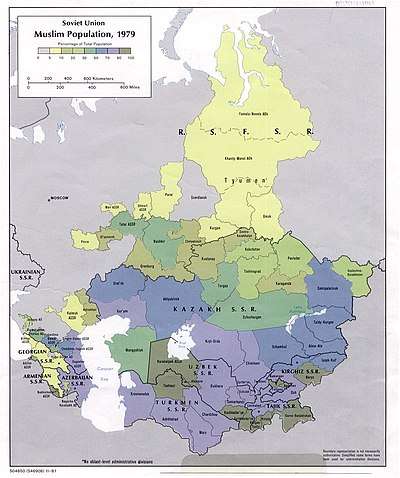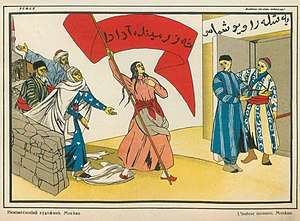Islam in the Soviet Union
The Union of Soviet Socialist Republics (USSR) was a federation made up of 15 Soviet socialist republics, and existed from 1922 until its dissolution in 1991. Six of the 15 republics had a Muslim majority: Azerbaijan, Kazakhstan, Kirghizia, Tajikistan, Turkmenistan, and Uzbekistan.[1] There was also a large Muslim population in the Volga-Ural region and in the northern Caucasus region of the Russian Soviet Federative Socialist Republic. Many Tatar Muslims also lived in Siberia and other regions.[1]

| Part of a series on the |
| Culture of the Soviet Union |
|---|
 |
| People |
| Languages |
| Traditions |
| Cuisine |
| Festivals |
|
Art |
| Literature |
|
Music and performing arts |
| Sport |
|
Monuments |
|
Symbols
|
|
In forming the USSR, the Bolsheviks wanted to include as much territory of the former Russian Empire as possible. This meant they were faced with conflict in attempting to establish communism in regions with strong Islamic influences. While actively encouraging atheism in the USSR, Soviet authorities allowed limited religious activities in the six Muslim republics.[2] Mosques operated in most large cities within these territories, though the number decreased dramatically from 25,000 in 1917 to 500 in the 1970s.
In 1989, as part of the relaxation of religious restrictions by the USSR, some additional Muslim associations were formed, and a number of the mosques that had been closed by the government were reopened. The Soviet government also announced plans to permit the education of a limited number of imams in the cities of Ufa and Baku.
By this time, Islam was the second-largest religion within the USSR, with between 45 and 50 million people identifying themselves as Muslims. However, only about 500 mosques were in operation and Soviet law forbade Islamic religious activity outside these mosques and Islamic schools. All of these facilities were supervised by four "spiritual directorates" established by the Soviet government to provide oversight. The Spiritual Directorate for Central Asia and Kazakhstan, the Spiritual Directorate for the European Soviet Union and Siberia, and the Spiritual Directorate for the Northern Caucasus and Dagestan oversaw Sunni Muslims, while the Spiritual Directorate for Transcaucasia dealt with both Sunni and Shia Muslims. The majority of the Muslims within the USSR were Sunnis, with only about 10% Shia Muslims, most of whom lived in Azerbaijan.[3]
Lenin's rule
In 1916, Bolshevik revolutionary Vladimir Lenin wrote Imperialism, the Highest Stage of Capitalism. This was a highly influential text in shaping Communist attitudes to colonial struggles, and led to a policy of cultivating left-wing nationalists within Muslim communities of Russia as well as foreign colonies. Before the October revolution, the first All-Russian Congress of Muslims was staged in Moscow in May 1917, celebrating the end of Tsarism.[4]
Compared to members of the Russian Orthodox Church, the Muslims of the Soviet Union were initially given more religious autonomy. This was in contrast to life under the Tsars, when Muslims were suppressed and the Eastern Orthodox Church was the official state religion. On 24 November 1917, weeks after the October revolution, the Bolsheviks issued an appeal to 'All the Muslim Workers of Russia and the East'.[4] Lenin declared;
Muslims of Russia…all you whose mosques and prayer houses have been destroyed, whose beliefs and customs have been trampled upon by the tsars and oppressors of Russia: your beliefs and practices, your national and cultural institutions are forever free and inviolate. Know that your rights, like those of all the peoples of Russia, are under the mighty protection of the revolution.[5]
Lenin even oversaw the return of certain religious artifacts such as the Uthman Quran.[5] Furthermore, some principles of Islamic law were instituted alongside the Communist legal system,[5] Jadids and other "Islamic socialists" were given positions of power within the government,[5] and an affirmative action system called "korenizatsiya" (nativisation) was implemented to help local Muslim populations.[5] Friday, the Muslim Sabbath, was declared a legal day of rest throughout Central Asia.[5]

Basmachi Movement
National Communism
Left-wing socialist Muslims began to develop a distinct variant of communism called "National communism" that continued in the USSR until 1928. The National communists believed the fate of world Communist revolution depended on events within Asia and not Europe. The National communists also argued that alliances with the Russian Bourgeoisie were necessary for the success of the revolution, and that class divisions had to be lessened or the Bourgeoisie would ally with outside Western powers and thus ensure the collapse of the USSR.
The Soviet government believed that such variation from traditional Communist Party doctrines would draw the attention of Western powers and invite intervention. This fear prompted the communist establishment to reject the arguments of the National communists as impractical at the September 1920 Baku Congress. This perceived lack of united ideals also prompted action against the National communists.[6]
The great purge of the Muslim republics began in 1928, with the executions of Veli Ibrahimov of the Tatar Communist Party and Milli Firka. These were followed by the elimination of the leaders of Hummet, the Tatar Communist Party, the Tatar Union of the Godless, and the Young Bukharians.
Stalin's rule
When Joseph Stalin consolidated power in the second half of the 1920s, his policy regarding religion had changed. Mosques began to be closed or turned into warehouses throughout Central Asia. Religious leaders were persecuted, religious schools were closed down and Waqfs were outlawed.[7] The Soviet government interpreted the paranji veil Muslim women wore as meaning they were oppressed, and began the Hujum to stop the practice.[5][8] The Hujum mainly backfired, and the veil became more popular than ever among the workers, whereas it had formerly been worn only by the Bourgeoise.[9]
Nonetheless, Stalin's cult of personality left little room for the practice of Islam, or any other religions.[5][8]
Ethnic cleansing
During World War II, particularly in 1943–44, the Soviet government conducted a series of deportations to Siberia and the Central Asian republics. Collaboration with Nazi Germany was cited as the official reason for the operation, but this has been disputed by accusations of ethnic cleansing against the USSR. The Crimean Tatars,[10] Chechens,[11] Ingushs, Balkars, Karachays, and Meskhetian Turks were some of the groups which were deported, all being predominantly Muslim.[12] Severe loss of life resulted during and after these deportations.
The mass deportation of Crimean Tatar Muslims began on 17 May 1944. More than 32,000 NKVD troops participated in deporting over 193,865 Crimean Tatars: 151,136 of them to Uzbek SSR, 8,597 to Mari ASSR, 4,286 to Kazakh SSR, and the remaining 29,846 to the various oblasts of RSFSR. According to NKVD data, nearly 20% died over the following year and a half, while Crimean Tatar activists have reported the figure to be nearly 46%.[13][14] (See Deportation of Crimean Tatars.)
See also
- Persecution of Muslims in the Soviet Union
- Soviet Orientalist studies in Islam
- Population transfer in the Soviet Union
- Deportation of Crimean Tatars
- Operation Lentil (Caucasus)
- Shami-Damulla
References
- Hannah, Abdul. "Chapter 1." Early History of Spread of Islam in (former) Soviet Union. 16 Sep 2002. Witness Pioneer. 14 Feb 2007
- "Soviet Union - POLICY TOWARD NATIONALITIES AND RELIGIONS IN PRACTICE". Retrieved 25 August 2016.
- "Soviet Union - Muslim". Retrieved 25 August 2016.
- Shindler, Colin (2012). Israel and the European Left. New York: Continuum. p. 44.
- Crouch, Dave. "The Bolsheviks and Islam." International Socialism: A quarterly journal of socialist theory. 110. 14 Feb 2007.
- Alexandre A. Bennigsen (15 September 1980). Muslim National Communism in the Soviet Union: A Revolutionary Strategy for the Colonial World. University of Chicago Press. p. 76. ISBN 978-0-226-04236-7. Retrieved 10 July 2013.
- Helene Carrere d’Encausse, The National Republics Lose Their Independence, in Edward A. Allworth, (edit), Central Asia: One Hundred Thirty Years of Russian Dominance, A Historical Overview, Duke University Press, 1994.
- Kowalsky, Sharon A. Book Review: Veiled Empire: Gender and Power in Stalinist Central Asia. by Douglas Northrop Archived 2007-04-29 at the Wayback Machine Journal of World History: Vol. 26, No. 2, June 2005.
- Douglas Northrop, Veiled Empire: Gender and Power in Stalinist Central Asia, Cornell University Press, 2004.
- Deportation of Crimean Tatars by Stalin Archived 2009-10-15 at the Wayback Machine
- "Remembering Stalin's deportations". 23 February 2004. Retrieved 25 August 2016 – via bbc.co.uk.
- Robert Conquest, The Nation Killers: The Soviet Deportation of Nationalities (London: Macmillan, 1970); S. Enders Wimbush and Ronald Wixman. 1975. "The Meskhetian Turks: A New Voice in Central Asia." Canadian Slavonic Papers 17 (Summer and Fall): 320-340; and Omer Bin Abdullah. Muslims of Chechnya continue their lonesome struggle for freedom, keeping Russian might in a bear trap. Archived 2006-06-20 at the Wayback Machine Islam Online. 03/02/2001
- "World War II -- 60 Years After: For Victims Of Stalin's Deportations, War Lives On". Retrieved 25 August 2016.
- "Crimean Tatars mark wartime deportations". 18 May 2002. Retrieved 25 August 2016 – via bbc.co.uk.
Further reading
- Nahaylo, Bohdan and Victor Swoboda. Soviet Disunion: A History of the nationalities Nationalities problem in the USSR (1990) excerpt
- Rashid, Ahmed. The Resurgence of Central Asia: Islam or Nationalism? (2017)
- Smith, Graham, ed. The Nationalities Question in the Soviet Union (2nd ed. 1995)
![]()
